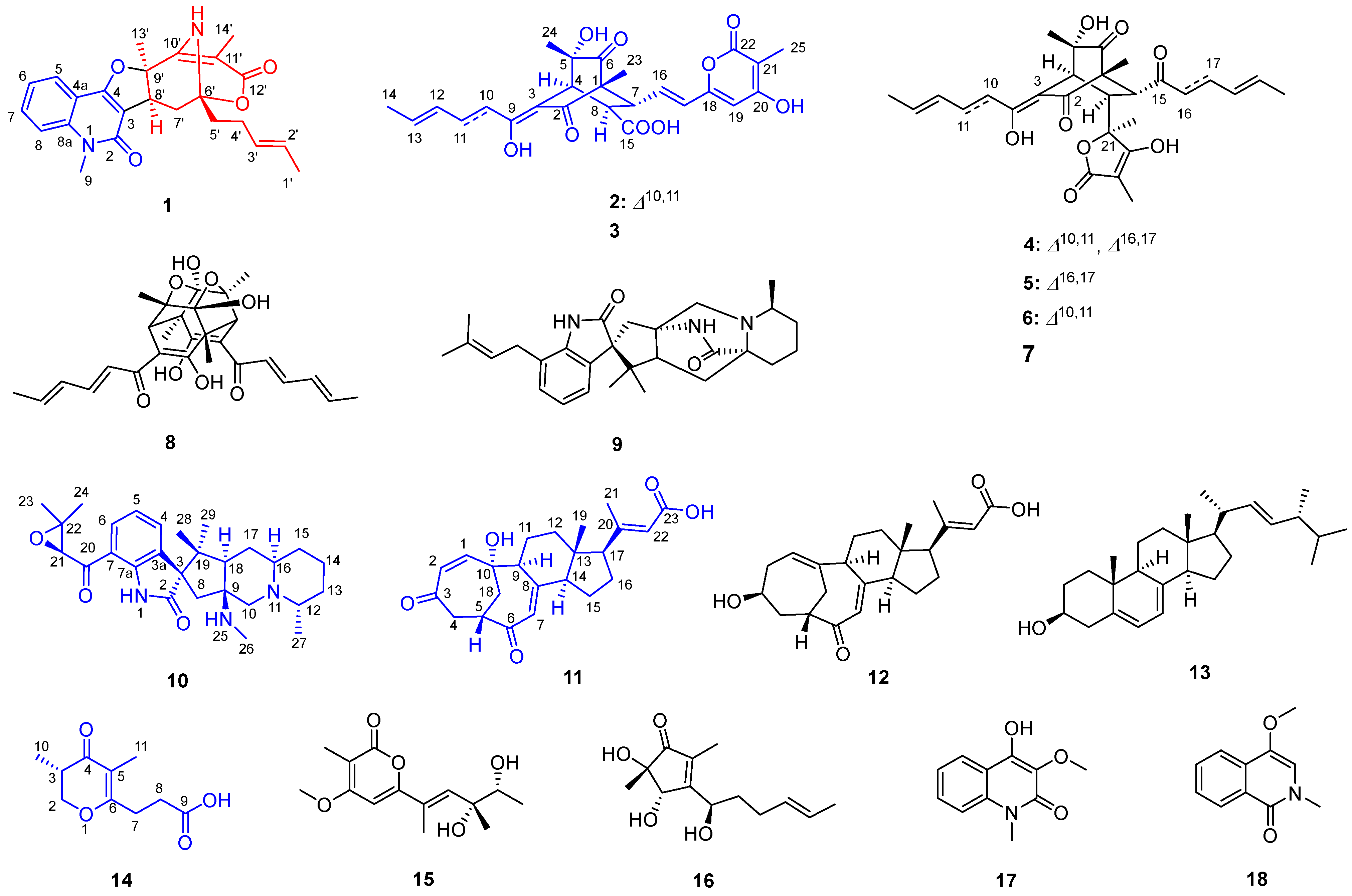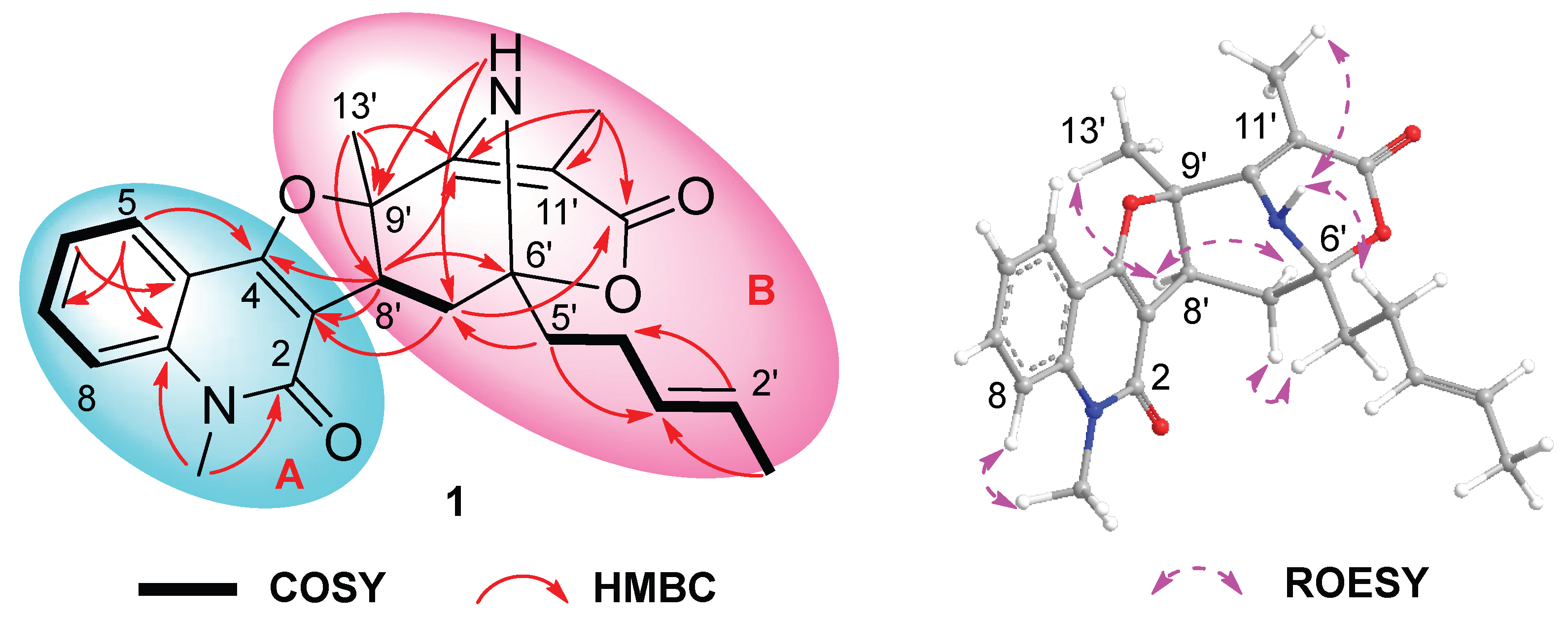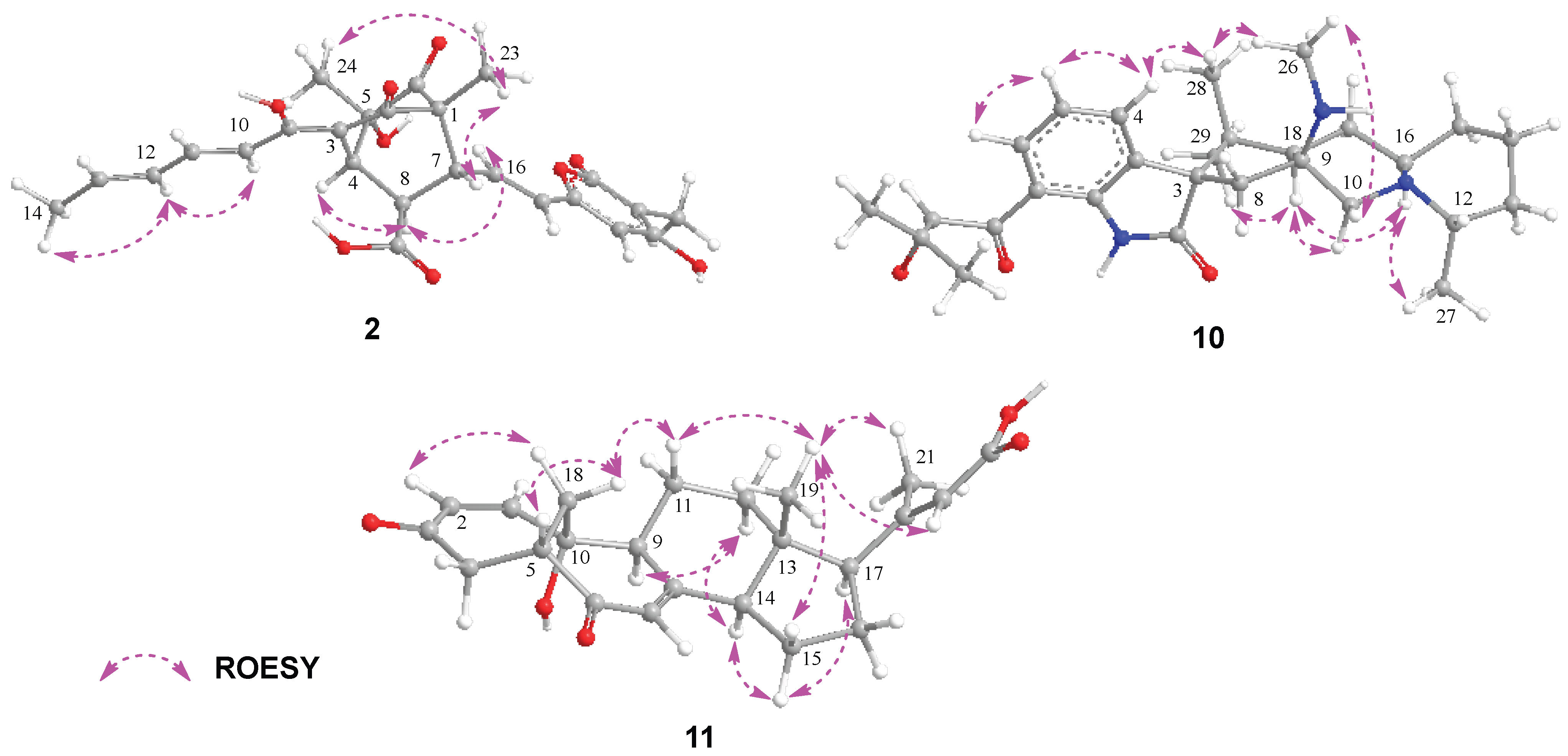Anti-Inflammatory Secondary Metabolites from Penicillium sp. NX-S-6
Abstract
1. Introduction
2. Results and Discussion
3. Materials and Methods
3.1. General Experimental Procedures
3.2. Fermentation, Extraction, Isolation, and Purification
3.3. Quantum Chemistry Calculation
3.4. Anti-Inflammatory Activity
4. Conclusions
Supplementary Materials
Author Contributions
Funding
Institutional Review Board Statement
Informed Consent Statement
Data Availability Statement
Conflicts of Interest
References
- Carroll, A.R.; Copp, B.R.; Grkovic, T.; Keyzers, R.A.; Prinsep, M.R. Marine natural products. Nat. Prod. Rep. 2025, 42, 257–297. [Google Scholar] [CrossRef] [PubMed]
- Li, S.; Xiao, Y.; Li, Q.; Su, M.; Guo, Y.; Jin, X. Recent advances in natural products derived from marine Echinoderms and endophytic microbes: Chemical insights and therapeutic potential. Mar. Drugs 2025, 23, 33. [Google Scholar] [CrossRef]
- Chhetri, B.K.; Tedbury, P.R.; Sweeney-Jones, A.M.; Mani, L.; Soapi, K.; Manfredi, C.; Sorscher, E.; Sarafianos, S.G.; Kubanek, J. Marine natural products as leads against SARS-CoV-2 infection. J. Nat. Prod. 2022, 85, 657–665. [Google Scholar] [CrossRef] [PubMed]
- Du, L.; Wilson, B.A.P.; Li, N.; Shah, R.; Dalilian, M.; Wang, D.; Smith, E.A.; Wamiru, A.; Goncharova, E.I.; Zhang, P.; et al. Discovery and synthesis of a naturally derived protein kinase inhibitor that selectively inhibits distinct classes of serine/threonine kinases. J. Nat. Prod. 2023, 86, 2283–2293. [Google Scholar] [CrossRef]
- Xue, D.; Zou, H.; Qiu, Y.; Lv, W.; Madden, M.D.; Xu, M.; Lian, X.; Pulliam, C.; Older, E.A.; Hou, L.; et al. Discovery of acylsulfenic acid-featuring natural product sulfenicin and characterization of its biosynthesis. Nat. Chem. 2025; Online ahead of print. [Google Scholar] [CrossRef]
- Li, Y.; Li, G.; Feng, J.; Li, S.; Liu, N. Advances in research on marine natural products for modulating the inflammatory microenvironment. Phytother. Res. 2025, 39, 1238–1258. [Google Scholar] [CrossRef] [PubMed]
- Teufel, R.; Muller, M. Giant polyketide synthases biosynthesize a marine polyether biotoxin. Angew. Chem. Int. Ed. Engl. 2025, 64, e202419620. [Google Scholar] [CrossRef]
- Kahlert, L.; Bassiony, E.F.; Cox, R.J.; Skellam, E.J. Diels-Alder reactions during the biosynthesis of sorbicillinoids. Angew. Chem. Int. Ed. Engl. 2020, 59, 5816–5822. [Google Scholar] [CrossRef]
- Milzarek, T.M.; Gulder, T.A.M. The fungal natural product class of the sorbicillinoids: Structures, bioactivities, biosynthesis, and synthesis. Nat. Prod. Rep. 2025, 42, 482–500. [Google Scholar] [CrossRef]
- Meng, J.; Wang, X.; Xu, D.; Fu, X.; Zhang, X.; Lai, D.; Zhou, L.; Zhang, G. Sorbicillinoids from fungi and their bioactivities. Molecules 2016, 21, 715. [Google Scholar] [CrossRef]
- Zhang, P.; Deng, Y.; Lin, X.; Chen, B.; Li, J.; Liu, H.; Chen, S.; Liu, L. Anti-inflammatory mono- and dimeric sorbicillinoids from the marine-derived fungus Trichoderma reesei 4670. J. Nat. Prod. 2019, 82, 947–957. [Google Scholar] [CrossRef]
- Chen, S.; Guo, H.; Wu, Z.; Wu, Q.; Jiang, M.; Li, H.; Liu, L. Targeted discovery of sorbicillinoid pigments with anti-inflammatory activity from the sponge-derived fungus Stagonospora sp. SYSU-MS7888 using the PMG strategy. J. Agric. Food Chem. 2022, 70, 15116–15125. [Google Scholar] [CrossRef] [PubMed]
- Zhang, K.; Liu, J.; Jiang, Y.; Sun, S.; Wang, R.; Sun, J.; Ma, C.; Chen, Y.; Wang, W.; Hou, X.; et al. Sorbremnoids A and B: NLRP3 inflammasome inhibitors discovered from spatially restricted crosstalk of biosynthetic pathways. J. Am. Chem. Soc. 2024, 146, 18172–18183. [Google Scholar] [CrossRef] [PubMed]
- Pang, X.; Ren, X.; Chen, W.; Yang, B.; Zhou, X.; Tian, X.; Guo, P.; Wang, J.; Liu, Y. Sorbicillalanines A and B, two [6,5,6] hybrid-sorbicillinoid alkaloids from Deep-Sea-Derived Penicillium sp. co-cultured with sponge-derived Setosphaeria sp. Org. Lett. 2025, 27, 6042–6046. [Google Scholar] [CrossRef]
- Cram, D.J. Mold metabolites. II. The structure of sorbicillin, a pigment produced by the mold Penicillium notatum. J. Am. Chem. Soc. 1948, 70, 4240–4243. [Google Scholar] [CrossRef]
- Xia, Y.P.; Xie, Y.; Rao, L.; Yin, G.P. Bioactive sorbicillinoid derivatives from an endophytic fungus Trichoderma citrinoviride. Front. Microbiol. 2025, 16, 1485032. [Google Scholar] [CrossRef]
- Pang, X.; Wang, P.; Liao, S.; Zhou, X.; Lin, X.; Yang, B.; Tian, X.; Wang, J.; Liu, Y. Three unusual hybrid sorbicillinoids with anti-inflammatory activities from the deep-sea derived fungus Penicillium sp. SCSIO06868. Phytochemistry 2022, 202, 113311. [Google Scholar] [CrossRef] [PubMed]
- Zhao, H.; Yang, A.; Zhang, N.; Li, S.; Yuan, T.; Ding, N.; Zhang, S.; Bao, S.; Wang, C.; Zhang, Y.; et al. Insecticidal endostemonines A-J produced by endophytic Streptomyces from Stemona sessilifolia. J. Agric. Food Chem. 2020, 68, 1588–1595. [Google Scholar] [CrossRef]
- Zhao, H.; Yang, A.; Liu, J.; Bao, S.; Peng, R.; Hu, Y.; Yuan, T.; Hou, S.; Xie, T.; Zhang, Q.; et al. Chartspiroton, a tetracyclic spiro-naphthoquinone derivative from a medicinal plant endophytic Streptomyces. Org. Lett. 2020, 22, 3739–3743. [Google Scholar] [CrossRef]
- Yang, A.; Hong, Y.; Zhou, F.; Zhang, L.; Zhu, Y.; Wang, C.; Hu, Y.; Yu, L.; Chen, L.; Wang, X. Endophytic microbes from medicinal plants in Fenghuang Mountain as a source of antibiotics. Molecules 2023, 28, 6301. [Google Scholar] [CrossRef]
- Yao, G.; Chen, X.; Zheng, H.; Liao, D.; Yu, Z.; Wang, Z.; Chen, J. Genomic and chemical investigation of bioactive secondary metabolites from a marine-derived fungus Penicillium steckii P2648. Front. Microbiol. 2021, 12, 600991. [Google Scholar] [CrossRef]
- Wang, X.; Elshahawi, S.I.; Shaaban, K.A.; Fang, L.; Ponomareva, L.V.; Zhang, Y.; Copley, G.C.; Hower, J.C.; Zhan, C.G.; Kharel, M.K.; et al. Ruthmycin, a new tetracyclic polyketide from Streptomyces sp. RM-4-15. Org. Lett. 2014, 16, 456–459. [Google Scholar] [CrossRef] [PubMed]
- Peng, H.; Zeng, Y.; Zhang, R.; Yang, L.; Wu, F.; Gai, C.; Yuan, J.; Chang, W.; Dai, H.; Wang, X. Cembranoid diterpenes from South China Sea soft coral Sarcophyton crassocaule. Mar. Drugs 2024, 22, 536. [Google Scholar] [CrossRef] [PubMed]
- Zhao, F.; Liu, Z.; Yang, S.; Ding, N.; Gao, X. Quinolactacin biosynthesis involves non-ribosomal-peptide-synthetase-catalyzed Dieckmann condensation to form the quinolone-gamma-lactam hybrid. Angew. Chem. Int. Ed. Engl. 2020, 59, 19108–19114. [Google Scholar] [CrossRef] [PubMed]
- Pang, X.; Zhou, X.; Lin, X.; Yang, B.; Tian, X.; Wang, J.; Xu, S.; Liu, Y. Structurally various sorbicillinoids from the deep-sea sediment derived fungus Penicillium sp. SCSIO06871. Bioorg. Chem. 2021, 107, 104600. [Google Scholar] [CrossRef]
- Mugishima, T.; Tsuda, M.; Kasai, Y.; Ishiyama, H.; Fukushi, E.; Kawabata, J.; Watanabe, M.; Akao, K.; Kobayashi, J. Absolute stereochemistry of citrinadins A and B from marine-derived fungus. J. Org. Chem. 2005, 70, 9430–9435. [Google Scholar] [CrossRef]
- Bian, Z.; Marvin, C.C.; Pettersson, M.; Martin, S.F. Enantioselective total syntheses of citrinadins A and B. Stereochemical revision of their assigned structures. J. Am. Chem. Soc. 2014, 136, 14184–14192. [Google Scholar] [CrossRef]
- He, Z.H.; Xie, C.L.; Wu, T.; Yue, Y.T.; Wang, C.F.; Xu, L.; Xie, M.M.; Zhang, Y.; Hao, Y.J.; Xu, R.; et al. Tetracyclic steroids bearing a bicyclo [4.4.1] ring system as potent antiosteoporosis agents from the deep-sea-derived Fungus Rhizopus sp. W23. J. Nat. Prod. 2023, 86, 157–165. [Google Scholar] [CrossRef]
- Wu, Z.; Guo, H.; Wu, Q.; Jiang, M.; Chen, J.; Chen, B.; Li, H.; Liu, L.; Chen, S. Absolute configuration of cyclopropanes and the structural revision of pyrones from marine-derived fungus Stagonospora sp. SYSU-MS7888. Bioorg. Chem. 2023, 136, 106542. [Google Scholar] [CrossRef]
- Shirota, O.; Pathak, V.; Hossain, C.F.; Sekita, S.; Takatori, K.; Satake, M. Structural elucidation of trichotetronines: Polyketides possessing a bicyclo [2.2.2]octane skeleton with a tetronic acid moiety isolated from Trichoderma sp. J. Chem. Soc. Perkin Trans. 1997, 1, 2961–2964. [Google Scholar]
- Yu, J.; Han, H.; Zhang, X.; Ma, C.; Sun, C.; Che, Q.; Gu, Q.; Zhu, T.; Zhang, G.; Li, D. Discovery of two new sorbicillinoids by overexpression of the global regulator LaeA in a marine-derived fungus Penicillium dipodomyis YJ-11. Mar. Drugs 2019, 17, 446. [Google Scholar] [CrossRef]
- Barnes-Seeman, D.; Corey, E.J. A two-step total synthesis of the natural pentacycle trichodimerol, a novel inhibitor of TNF-alpha production. Org. Lett. 1999, 1, 1503–1504. [Google Scholar] [CrossRef] [PubMed]
- Nicolaou, K.C.; Simonsen, K.B.; Vassilikogiannakis, G.; Baran, P.S.; Vidali, V.P.; Pitsinos, E.N.; Couladouros, E.A. Biomimetic explorations towards the bisorbicillinoids: Total synthesis of bisorbicillinol, bisorbibutenolide, and trichodimerol. Angew. Chem. Int. Ed. Engl. 1999, 38, 3555–3559. [Google Scholar] [CrossRef]
- Lin, Z.; Wen, J.; Zhu, T.; Fang, Y.; Gu, Q.; Zhu, W. Chrysogenamide A from an endophytic fungus associated with Cistanche deserticola and its neuroprotective effect on SH-SY5Y cells. J. Antibiot. 2008, 61, 81–85. [Google Scholar] [CrossRef]
- Fang, F.; Zhao, J.; Ding, L.; Huang, C.; Naman, C.B.; He, S.; Wu, B.; Zhu, P.; Luo, Q.; Gerwick, W.H.; et al. 5-hydroxycyclopenicillone, a new beta-amyloid fibrillization inhibitor from a sponge-derived fungus Trichoderma sp. HPQJ-34. Mar. Drugs 2017, 15, 260. [Google Scholar] [CrossRef]
- Zhang, G.; Chen, Z.; Ruan, J.; Xu, L.; Li, G.; Luo, L. A new isoquinolone alkaloid from Penicillium citrinum P4-5-1, an endophytic fungus isolated from mangrove plant Acanthus ilicifolius. Chin. J. Mar. Drugs 2023, 42, 31–35. [Google Scholar]
- Hu, Y.; Yang, H.; Ding, X.; Liu, J.; Wang, X.; Hu, L.; Liu, M.; Zhang, C. Anti-inflammatory octahydroindolizine alkaloid enantiomers from Dendrobium crepidatum. Bioorg. Chem. 2020, 100, 103809. [Google Scholar] [CrossRef]
- Frisch, M.J.; Trucks, G.W.; Schlegel, H.B.; Scuseria, G.E.; Robb, M.A.; Cheeseman, J.R.; Scalmani, G.; Barone, V.; Mennucci, B.; Petersson, G.A.; et al. Gaussian 09, Revision E.01; Gaussian, Inc.: Wallingford, CT, USA, 2013. [Google Scholar]
- Srebro-Hooper, M.; Autschbach, J. Calculating natural optical activity of molecules from first principles. J. Annu. Rev. Phys. Chem. 2017, 68, 399–420. [Google Scholar] [CrossRef] [PubMed]
- Bruhn, T.; Schaumlöffel, A.; Hemberger, Y. SpecDis, Version 1.64; University of Wuerzburg: Würzburg, Germany, 2015. [Google Scholar]
- Wang, J.; Li, H.; Li, Y.; Yang, A.; Bao, S.; Zhang, Y.; Du, Q.; Zheng, Z.; Wang, X. Sinoflavonoids NJ and NK, anti-inflammatory prenylated flavonoids from the fruits of Podophyllum hexandrum Royle. Nat. Prod. Res. 2024, 38, 701–705. [Google Scholar] [CrossRef]






| No. | δC, Type | δH (J in Hz) | No. | δC, Type | δH (J in Hz) |
|---|---|---|---|---|---|
| 2 | 162.3, C | 4′ | 26.9, CH2 | 2.41, m | |
| 3 | 105.3, C | 5′ | 39.4, CH2 | 2.17, t (7.8) | |
| 4 | 155.9, C | 6′ | 89.2, C | ||
| 4a | 114.9, C | 7′ | 31.1, CH2 | 2.08, m 2.62, dd (14.0, 2.3) | |
| 5 | 122.7, CH | 7.84, d (7.9) | 8′ | 34.7, CH | 3.84, brs |
| 6 | 121.8, CH | 7.23, t (7.6) | 9′ | 82.0, C | |
| 7 | 131.3, CH | 7.59, t (7.7) | 10′ | 165.6, C | |
| 8 | 114.5, CH | 7.34, d (8.5) | 11′ | 101.2, C | |
| 8a | 139.6, C | 12′ | 173.5, C | ||
| 9 | 29.9, CH3 | 3.70, s | 13′ | 26.0, CH3 | 1.75, s |
| 1′ | 18.1, CH3 | 1.73, d (6.2) | 14′ | 6.5, CH3 | 1.51, s |
| 2′ | 127.0, CH | 5.65, m | N-H | 4.94, brs | |
| 3′ | 129.9, CH | 5.58, m |
| No. | 2 a | 10 b | 11 a | |||
|---|---|---|---|---|---|---|
| δC, type | δH (J in Hz) | δC, type | δH (J in Hz) | δC, type | δH (J in Hz) | |
| 1 | 64.3, C | 9.80, s | 149.8, CH | 6.09, d (13.0) | ||
| 2 | 199.1, C | 183.5, C | 130.6, CH | 5.78 c | ||
| 3 | 109.1, C | 60.2, C | 204.0, C | |||
| 3a | 132.4, C | |||||
| 4 | 46.2, CH | 3.67, d (2.7) | 133.0, CH | 7.85, d (7.6) | 47.7, CH2 | 2.67, d (17.9) 3.43, d (17.9) |
| 5 | 74.9, C | 122.4, CH | 7.16, t (7.8) | 44.0, CH | 2.93, m | |
| 6 | 210.4, C | 128.0, CH | 7.72, d (8.0) | 204.8, C | ||
| 7 | 48.8, CH | 3.21, dd (10.1, 5.5) | 117.2, C | 125.4, CH | 5.76 c | |
| 7a | 143.2, C | |||||
| 8 | 45.7, CH | 3.46, dd (5.5, 2.7) | 41.0, CH2 | 2.20 d (15.0) 2.59 d (15.0) | 157.3, C | |
| 9 | 170.0, C | 64.2, C | 59.1, CH | 2.57, m | ||
| 10 | 119.5, CH | 6.42 c | 57.5, CH2 | 3.24, d (12.7) 3.62, d (12.7) | 74.9, C | |
| 11 | 143.6, CH | 7.34, dd (14.9, 15.0) | 25.6, CH2 | 1.84, m 2.37, d (13.7) | ||
| 12 | 140.5, CH | 6.25 c | 58.6, CH | 3.78, m | 39.5, CH2 | 1.66 c, 2.02 c |
| 13 | 132.3, CH | 6.42 c | 29.5, CH2 | 1.73, 2.34, m | 50.9, C | |
| 14 | 18.9, CH3 | 1.92, d (7.5) | 17.1, CH2 | 1.72, m | 58.7, CH | 2.49, dd (11.6, 6.7) |
| 15 | 176.1, C | 30.5, CH2 | 1.92, m | 23.6, CH2 | 1.66 c, 1.78, m | |
| 16 | 135.9, CH | 6.27 c | 58.9, CH | 3.29, m | 25.5, CH2 | 1.90, m, 2.01 c |
| 17 | 126.1, CH | 6.18, d (15.3) | 25.9, CH2 | 1.77, 2.13, m | 61.7, CH | 2.60, m |
| 18 | 156.7, C | 53.7, CH | 2.83, dd (13.6, 2.8) | 35.1, CH2 | 2.07, d (15.4) 3.11, dd (15.4, 7.9) | |
| 19 | 102.6, CH | 6.09, s | 47.5, C | 13.9, CH3 | 0.66, s | |
| 20 | 167.2, C | 195.0, C | 160.2, C | |||
| 21 | 101.3, C | 64.5, CH | 4.05, s | 20.7, CH3 | 2.22, s | |
| 22 | 167.7, C | 61.8, C | 118.0, CH | 5.78 c | ||
| 23 | 11.0, CH3 | 1.11, s | 18.7, CH3 | 1.22, s | 170.2 C | |
| 24 | 23.7, CH3 | 1.25, s | 24.4, CH3 | 1.61, s | ||
| 25 | 8.6, CH3 | 1.91, s | ||||
| 26 | 29.6, CH3 | 2.65, s | ||||
| 27 | 11.8, CH3 | 1.43, d (6.8) | ||||
| 28 | 23.5, CH3 | 1.14, s | ||||
| 29 | 24.7, CH3 | 0.93, s | ||||
| No. | δC, Type | δH (J in Hz) | No. | δC, Type | δH (J in Hz) |
|---|---|---|---|---|---|
| 2 | 72.7, CH2 | 3.97, t (10.9) 4.36, dd (10.9, 5.2) | 7 | 27.1, CH2 | 2.70, m |
| 3 | 38.9, CH | 2.55, m | 8 | 30.2, CH2 | 2.65, m |
| 4 | 195.4, C | 9 | 177.2, C | ||
| 5 | 110.0, C | 10 | 11.6, CH3 | 1.10, d (7.1) | |
| 6 | 169.4, C | 11 | 9.4, CH3 | 1.75, s |
| Compounds | NO | IL-6 |
|---|---|---|
| 1 | 34.28 ± 4.00 | 13.51 ± 6.70 |
| 2 | 56.71 ± 0.22 | ≥100 |
| 4 | 17.11 ± 9.28 | 28.36 ± 4.79 |
| 6 | 70.24 ± 18.73 | ≥100 |
| 8 | 6.63 ± 1.13 | 13.59 ± 0.79 |
| 9 | 36.84 ± 2.55 | ≥100 |
| 11 | 53.86 ± 12.55 | ≥100 |
| Dexamethasone | 5.24 ± 0.68 | 7.80 ± 0.92 |
Disclaimer/Publisher’s Note: The statements, opinions and data contained in all publications are solely those of the individual author(s) and contributor(s) and not of MDPI and/or the editor(s). MDPI and/or the editor(s) disclaim responsibility for any injury to people or property resulting from any ideas, methods, instructions or products referred to in the content. |
© 2025 by the authors. Licensee MDPI, Basel, Switzerland. This article is an open access article distributed under the terms and conditions of the Creative Commons Attribution (CC BY) license (https://creativecommons.org/licenses/by/4.0/).
Share and Cite
Peng, H.; Sun, J.; Zhang, R.; Qiu, Y.; Hong, Y.; Zhou, F.; Wang, C.; Hu, Y.; Wang, X. Anti-Inflammatory Secondary Metabolites from Penicillium sp. NX-S-6. Mar. Drugs 2025, 23, 280. https://doi.org/10.3390/md23070280
Peng H, Sun J, Zhang R, Qiu Y, Hong Y, Zhou F, Wang C, Hu Y, Wang X. Anti-Inflammatory Secondary Metabolites from Penicillium sp. NX-S-6. Marine Drugs. 2025; 23(7):280. https://doi.org/10.3390/md23070280
Chicago/Turabian StylePeng, Hanyang, Jiawen Sun, Rui Zhang, Yuxuan Qiu, Yu Hong, Fengjuan Zhou, Chang Wang, Yang Hu, and Xiachang Wang. 2025. "Anti-Inflammatory Secondary Metabolites from Penicillium sp. NX-S-6" Marine Drugs 23, no. 7: 280. https://doi.org/10.3390/md23070280
APA StylePeng, H., Sun, J., Zhang, R., Qiu, Y., Hong, Y., Zhou, F., Wang, C., Hu, Y., & Wang, X. (2025). Anti-Inflammatory Secondary Metabolites from Penicillium sp. NX-S-6. Marine Drugs, 23(7), 280. https://doi.org/10.3390/md23070280





